서론: 마켓플레이스 시장 및 시나리오
2030년까지 패션 마켓플레이스는 전체 온라인 패션 매출의 50%를 차지할 것으로 예상됩니다. 이러한 이유로 패션 브랜드는 패션 마켓플레이스 관리에 성공하는 데 필요한 기술을 즉시 습득해야 합니다.
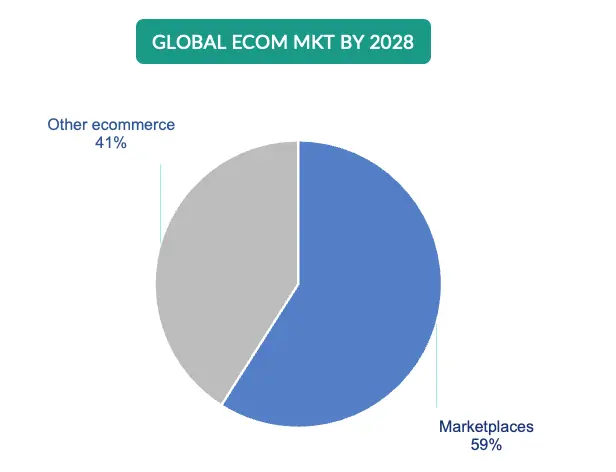
Marketplaces like Farfetch, MyTheresa and Zalando offer the opportunity to reach new consumers and increase sales volumes. However, large marketplaces put constraints to what brands can and can’t do and impose processes that fashion brands need to strictly follow if they want to be present on these fashion marketplaces online.
패션 마켓플레이스란?
A fashion marketplace is an online platform that connects multiple fashion brands and retailers with consumers, allowing various sellers to showcase and sell their products in a centralized digital space. Unlike traditional e-commerce stores operated by single brands, these fashion marketplaces offer a diverse range of styles, price points, and brands, providing consumers with a comprehensive shopping experience. Whether it’s a mainstream online fashion marketplace or a niche luxury fashion marketplace, consumers can discover a wide variety of options.
Want to Master Marketplace Management?
Navigating the complex world of fashion marketplaces online requires careful planning and strategy. If you’re a fashion brand looking to optimize your presence across these platforms, keep reading this guide for expert insights. Plus, consider taking our Marketplace Management Online Course for an in-depth, hands-on approach to maximizing your sales and brand visibility across top platforms like Farfetch, MyTheresa, and Zalando. – leaders in the fashion online marketplace space.
What the Risks of Selling on Marketplaces?
Fashion Marketplaces present opportunities but also threats. For example, the high commissions fees that fashion brands have to pay to the marketplace fashion platforms, poses a significant threat to the 수익성 of the online ecommerce sales on fashion marketplaces.
Another important decision for fashion brands is whether or not selling on specific fashion marketplace platforms in order not to go into competition with the main ecommerce channel of the brand or with wholesale clients who are selling online on fashion marketplaces in specific regions. Decisions around luxury brand positioning also play a critical role when it comes to choosing the right platforms.
If you work in a fashion brands and you want to learn how to manage fashion marketplaces keep reading this guide and consider taking the 마켓플레이스 관리 온라인 코스. Learning to navigate marketplaces fashion effectively can help you scale while protecting your margins and brand image.
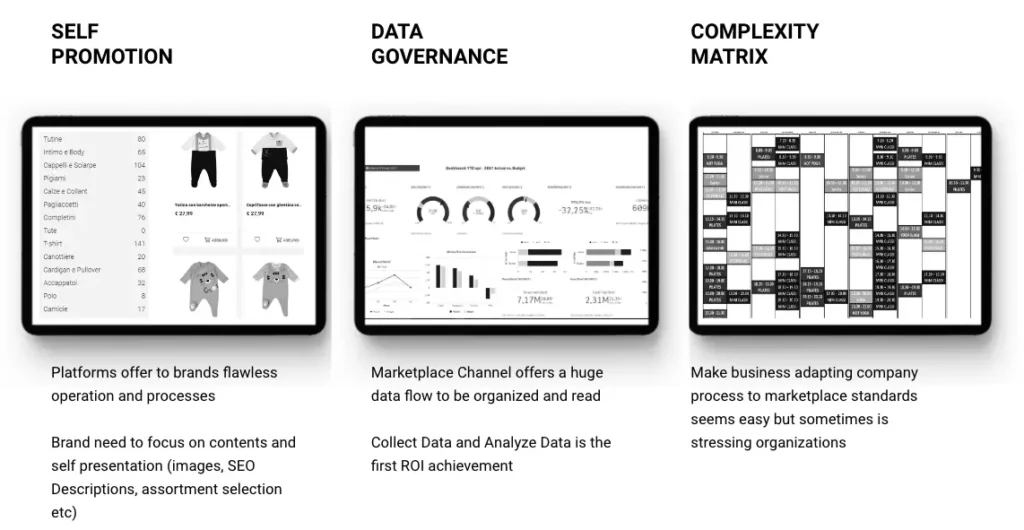
Use Cases: why selling on marketplaces.
A) The shoes brand A that is very strong in the southern Europe may utilize marketplaces in US and in the North of Europe to investigate the market potential leveraging the traffic of the marketplaces. For example the brand could integrate with Zalando, Galeries Lafayette and Miinto for the North of Europe and Neimann Marcus and Sacks Fifth Avenue for the US.
B) The clothing brand B needs to acquire new customers who may become brand lovers if they only tried the brand B products. The brand B decides to run a sales event on VeePee network where new customers can try the brand B products by buying the products with 50% to 70% discount. The happy customers will then become brands customer and buy also from the DTC ecommerce.
C) Brand C sells well jeans in North of Europe market but want to target people who buy total looks from luxury department stores, therefore Brand C decides to activate the Breuninger Marketplace and list a selection of products on the Department store’s marketplace so that the customers of the Department store can buy also the Brand C products when they shop for Looks
D) Brand D sees that its products are sold on a marketplace by a multitude of sellers who sell both second hand and new products, the Gross Merchandise value is estimated around 1 million Euros per year. The Brand D decides to open the official brand channel directly on the marketplace and acquired 75 percent of share of the brand sales on that specific marketplace.

추가 정보가 필요하면 저자에게 문의하세요: Enrico Fantaguzzi, Filippo Quattrone. 저자에 대한 정보
Fashion marketplaces such as Farfetch, Zalando and Nordstrom offer a significant opportunity for fashion & luxury brands to 전 세계의 새로운 고객에게 다가가세요. 하지만, 이 경쟁적인 환경에서 성공하려면 전략적 접근 방식이 필요합니다., tailored to the unique challenges of luxury brand positioning and a 비용과 수익의 신중한 계획.
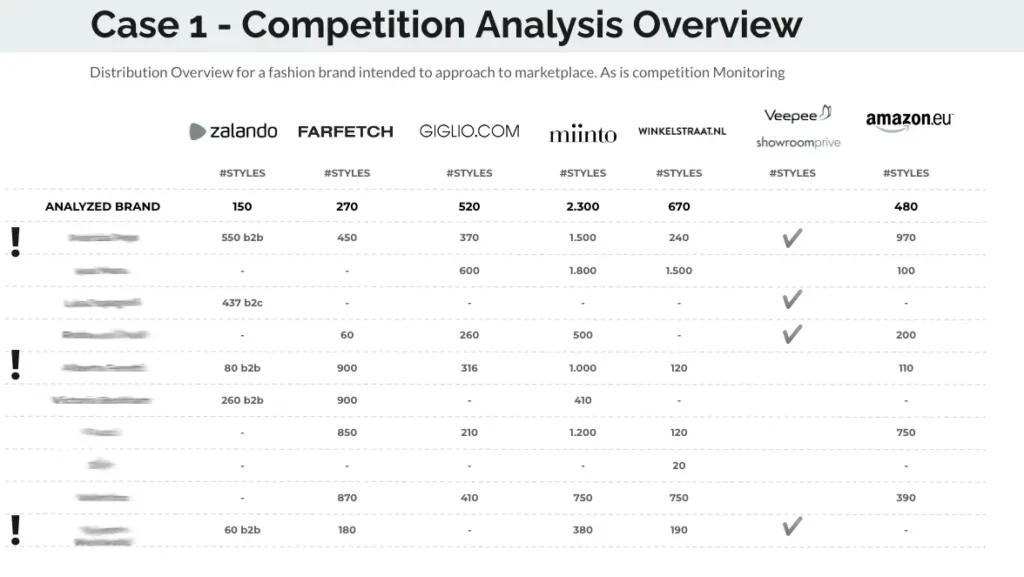
How Do the Marketplaces Work?
A fashion marketplace is an online platform that connects buyers and sellers 판매자가 브랜드이고 고객이 제품의 최종 소비자인 경우, 브랜드의 경우 B2C 비즈니스 모델입니다.
Fashion marketplaces allow brands to virtually multiply the visibility of the products by publishing them on multiple sales channels (online marketplaces) while the products are sitting in the brand’s warehouse (Drop Shipping). These fashion marketplaces online enable scalable growth without upfront inventory relocation
Stock, prices, descriptions, images and fashion marketplace management strategy are controlled by the brand
Every time there is a sale on the fashion marketplace, the product is sold to the customer and shipped to the customer from the supplier – the brand or the seller.
Why Fashion Marketplaces Are a Major Opportunity for Fashion Brands
Selling on Marketplaces is important for fashion and luxury brands for a number of reasons:
- Internationalization: Marketplaces allow brands to reach new customers in many different countries.
- Low capex investments: Selling on online fashion marketplaces don’t require the set-up of an e-commerce platform and the costs are mainly variable.
- Low stock risk (Dropship Model): Fashion brands can sell the stock that they already have in their warehouse on multiple fashion marketplace online channels.
- New customer base: Markeplaces allow fashion brands to reach new customers.
- Reduce inventories: Marketplaces allow fashion brands to sell the same stock on different channels.
- Brand Image Control: The advantage of Marketplaces compared to resellers is that fashion brands can control price and image – crticial for luxury brand positioning.
- 데이터 수집: 마켓플레이스에서 판매하면 분석할 수 있는 더 많은 판매 데이터를 수집할 수 있습니다.
Ready to Maximize Your Brand’s Potential?
The fashion marketplace is an exciting and ever-evolving landscape, full of potential for brands aiming to grow their digital presence and reach new customer segments. From global giants like Zalando and Amazon to curated platforms like Farfetch and Yoox, each fashion marketplace offers unique opportunities to boost visibility, drive sales, and build brand recognition.
Success in this space isn’t just about showing up—it’s about mastering the rules, understanding the algorithms, and tailoring your strategies to each platform’s structure and audience. If you’re a fashion brand eager to tap into this goldmine of opportunity, learning how to effectively navigate and manage your fashion marketplace presence is not just beneficial—it’s essential.
Stay tuned for more expert insights, tips, and tools to help you thrive in the world of online fashion marketplaces.
A List of Fashion & Luxury Marketplaces With a Brief Description
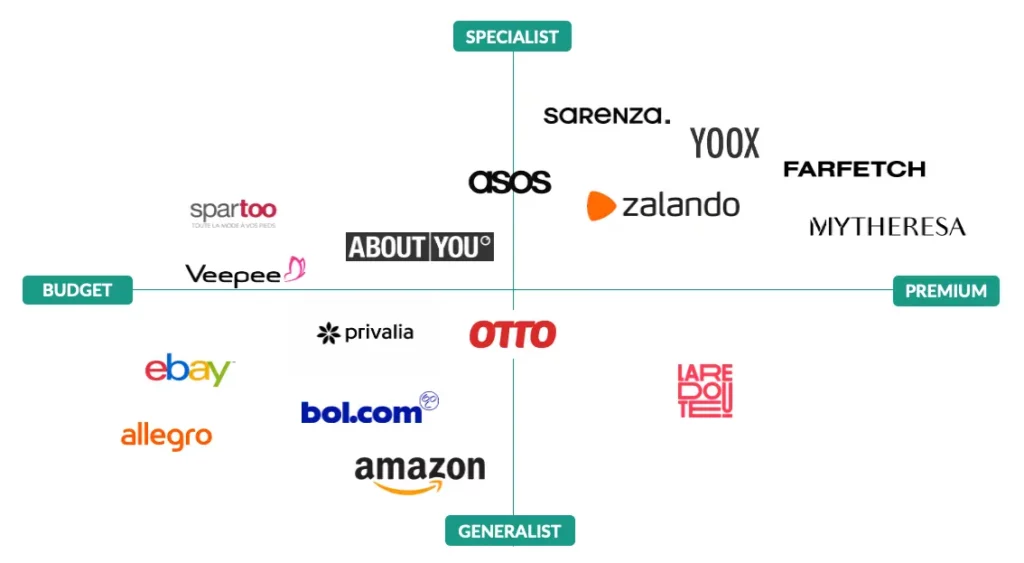
- 파페치: 럭셔리 패션 브랜드를 위한 글로벌 마켓플레이스입니다. 전 세계의 브랜드와 고객을 연결하며, 고급 쇼핑 경험을 제공합니다. 최근 Kering Group의 일부 브랜드가 이 마켓플레이스에서 직접 입지를 줄이기 시작했습니다. 자세한 내용은 다음에서 확인하세요. 패션 네트워크.
- 브로이닝거: 온라인 마켓플레이스를 갖춘 독일 백화점 체인입니다. 다양한 패션 브랜드와 가정용품, 액세서리를 제공합니다.
- 유크스: 럭셔리와 컨템포러리 등 다양한 패션 브랜드를 판매하는 이탈리아 온라인 리테일러입니다. 또한 중고 의류를 위한 재판매 마켓플레이스도 제공합니다.
- 잘란도: 저렴한 것부터 고급 브랜드까지 다양한 브랜드를 판매하는 독일 온라인 패션 리테일러입니다. 또한 독립 브랜드를 위한 마켓플레이스도 제공합니다.
- 미인토: 패션 브랜드를 위한 덴마크 온라인 마켓플레이스입니다. 유럽 전역의 브랜드와 고객을 연결하며, 다양한 스타일을 제공합니다.
- 삭스 피프스 애비뉴: 온라인 마켓플레이스를 갖춘 미국의 고급 백화점입니다. 다양한 패션 브랜드와 가정용품, 액세서리를 제공합니다.
- 오트리움: 전 세계 패션 브랜드에 대해 최대 70%의 할인을 제공하는 유럽 플래시 세일 마켓플레이스입니다.
- 비피: 전 세계 패션 브랜드에 대해 최대 70%의 할인을 제공하는 프랑스 플래시 세일 마켓플레이스입니다.
- 24s.com: 전 세계의 엄선된 브랜드를 제공하는 유럽의 럭셔리 패션 마켓플레이스입니다.
- 티몰: 패션, 가정용품, 전자제품 등 다양한 제품을 제공하는 중국 마켓플레이스입니다. 고급 브랜드를 위한 럭셔리 섹션이 있습니다.
- 메이시스: 온라인 마켓플레이스를 갖춘 미국의 백화점 체인입니다. 다양한 패션 브랜드와 가정용품, 액세서리를 제공합니다.
4. 패션 마켓플레이스에서 성공하는 방법
패션 마켓플레이스에서의 판매 전략
Success on an online fashion marketplace requires understanding the marketplace’s audience and aligning product offerings accordingly. High-quality images, detailed product descriptions, and competitive pricing are essential. Additionally, leveraging marketplace fashion promotions and participating in seasonal campaigns can enhance visibility on both mainstream and luxury fashion marketplace platforms.
가시성을 위한 제품 목록 최적화
Optimizing your listings is a cornerstone of effective fashion marketplace management. Utilizing relevant keywords, clear titles, and comprehensive descriptions improves searchability within the marketplace. Incorporating customer reviews and maintaining high ratings also boost credibility and attract more buyers.
마켓플레이스 알고리즘 및 프로모션 활용
Understanding and adapting to the marketplace’s algorithm can significantly impact product visibility. Engaging in promotional opportunities offered by the marketplaces – such as flash sales or featured listings, can drive traffic and increase sales. This is especially true for brands looking to strengthen their luxury brand positioning on curated fashion marketplaces.

업데이트를 놓치지 마세요
저희 메일링 목록에 가입하시면 교육 프로그램, 취업 기회, 무료 리소스에 대한 업데이트를 받아보실 수 있습니다.
What Are the Differences Between Drop shipping and Concession Models?
드롭시핑과 양보의 주요 차이점을 요약한 표는 다음과 같습니다.
| 특징 | 드롭시핑 | 양보 |
|---|---|---|
| 제품의 소유권 | 상인은 제품을 소유하지 않습니다 | 상인은 제품을 소유하지 않습니다 |
| 재고 관리 | 상인은 재고를 관리하지 않습니다 | 상인은 재고를 관리하지 않습니다 |
| 해운 | 판매자가 배송을 처리하지 않습니다 | 판매자가 배송을 처리하지 않습니다 |
| 가격 | 상인이 가격을 정한다 | 공급업체가 가격을 설정합니다 |
| 수수료 | 상인은 수수료를 받지 않습니다 | 판매자는 각 판매에 대해 수수료를 받습니다. |
| 마케팅 | 상인은 마케팅을 담당합니다 | 공급업체는 마케팅을 담당합니다. |
| 고객 서비스 | 상인은 고객 서비스에 대한 책임이 있습니다 | 공급업체는 고객 서비스에 대한 책임이 있습니다. |
Pros and Cons of Drop Shipping and Concession Models
Both drop shipping 그리고 concessions have their own advantages and disadvantages when selling on a fashion marketplace. 드롭시핑 is a more hands-off approach – often used in fashion marketplaces online, but it can be more difficult to control the customer experience.
양보, on the other hand, give the merchant more control over the customer experience within the fashion online marketplace, but it can be more time-consuming and require more upfront investment in fashion marketplace management.
The best approach for a particular merchant will depend on their specific goals and circumstances. If a merchant is looking for a low-cost, hands-off approach, then drop shipping may be the best approach. If a merchant is looking for more control over their brand image and customer journey – particularly in luxury fashion marketplaces – then the concession model may be the better approach.
드롭시핑과 양보 중에서 선택할 때 고려해야 할 추가 요소는 다음과 같습니다.
Markeplaces Integration and Workflow
주문 관리와 마켓플레이스와의 통합은 매우 복잡할 수 있으며, 정확한 계획, 정의 및 구성이 필요합니다.
이제 마켓플레이스에서 브랜드 판매를 구성하는 방법을 배울 수 있습니다. 마켓플레이스 온라인 코스 Digital Fashion Academy에 의해.
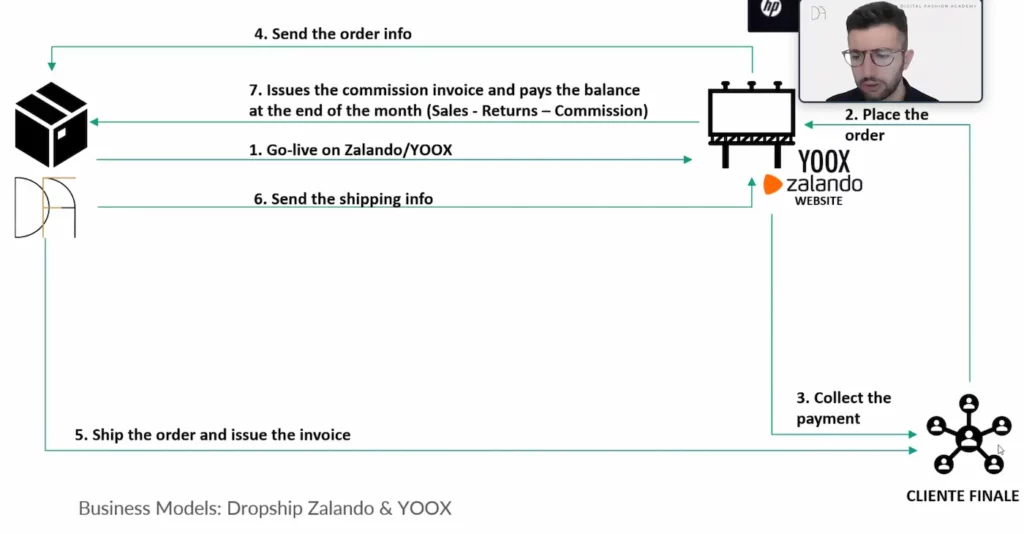
About the Authors

필리포 콰트론
마켓플레이스 부문 책임자 – 필로블루
패션 브랜드가 마켓플레이스 채널을 처음부터 끝까지 활성화할 수 있도록 지원하는 전략 관리 컨설턴트입니다.
그는 Accenture, Ralph Lauren, Valentino, OVS에서 일하며 관리 역할을 점점 더 많이 맡으면서 다양한 산업과 국제 기업에서 15년 이상의 경험을 쌓았습니다.

엔리코 판타구치
Digital Fashion Academy의 공동 창립자
Enrico Fantaguzzi는 패션 및 럭셔리 전자상거래 전문가이자 컨설턴트입니다. 그는 다음과 같은 브랜드에서 일했습니다. 구찌, 토즈, 울리치 그리고 e-tailers 같은 유크스.
10 Questions About Fashion Marketplaces That We Answered in Our Online Course.
패션 마켓플레이스의 비즈니스 모델을 심층적으로 살펴보고 비즈니스 계획 및 통합과 같은 특정 측면을 다루기 전에 패션 마켓플레이스에 대한 가장 일반적인 질문에 대한 간단한 답변을 찾을 수 있습니다.
- 어떤 상황에서 온라인 마켓플레이스가 유리할까요?
- 마켓플레이스를 통해 브랜드는 새로운 시장을 개척하다 브랜드에 특정 지역 역량이 없거나 브랜드 인지도가 부족한 경우. 이 경우 브랜드는 마켓플레이스를 사용하여 브랜드 인지도와 판매 확대.
- 또 다른 상황은 브랜드의 제품이 이미 시장에서 판매되고 있지만 여러 다른 판매자가 판매하는 경우입니다. 이 경우 브랜드는 다음을 원할 수 있습니다. 채널을 제어하다 직접 판매함으로써.
- 마켓플레이스와 직접 소비자(DTC) 전자상거래 사이에 공멸 현상이 있습니까?
- 공식화가 있는지 확인하려면 다음이 필요합니다. 매진 가격을 분석하다 그리고 카테고리별, 베스트셀러별 판매 상품. 이 분석 결과에 따라 다양한 채널 간에 잠재적인 공식화 또는 시너지가 있는지 결론을 내릴 수 있습니다. 이 주제에 대한 자세한 내용은 다음을 참조하세요. 마켓플레이스 코스.
- 온라인 마켓플레이스의 가격을 어떻게 통제할 수 있나요?
- 브랜드는 마켓플레이스에서 매진 가격을 모니터링할 수 있습니다. 특정 응용 프로그램 사용 시장을 스캔하고 브랜드에 결과를 제공하는 것. 대안적인 패션 브랜드는 이 분석을 서비스 제공자에게 위임합니다. 아웃소싱 분야에서 패션 브랜드의 마켓플레이스를 관리하는 사람입니다.
- 디지털 마켓플레이스에서 판매하는 데에는 어떤 이점이 있나요?
- 데이터를 수집하다 다양한 시장의 제품 선호도;
- 패션 제품 수명 주기 활용 프리미엄 채널에서 신제품을 판매하고, 할인 마켓플레이스에서 비수기 제품을 판매함으로써;
- 지역 시장에 특화된 마켓플레이스는 브랜드가 해당 시장에서 브랜드 인지도와 매출을 늘리세요.
- 마켓플레이스를 통해 브랜드는 새로운 고객을 확보하다 특정 마켓플레이스에서 구매를 하여 브랜드에 충성하는 고객으로 전환하는 사람들입니다.
- 마켓플레이스에서 판매할 때 지켜야 할 규칙은 무엇인가요?
- 마켓플레이스에서 판매하려면 배송 및 고객 서비스 등에 대한 마켓플레이스 서비스 수준 계약(SLA)을 따라야 합니다.
- 기술 통합: 커넥터 소프트웨어, 데이터 피드 및 매핑 사양
- 콘텐츠 가이드라인: 제품 이미지 설명, 마켓플레이스 브랜드 페이지 콘텐츠
- 가능하고 필요한 경우 마케팅과 광고 캠페인을 실행합니다.
- 마켓플레이스에서 판매하기 위해 필요한 전제 조건은 무엇입니까?
- 마켓플레이스에서 판매하기 전에 판매자 회사는 다음 사항을 준비해야 합니다. 표준 드롭시핑 프로세스 지원 여기에는 다음이 포함됩니다:
- 물류 B2C 기능: 픽업, 포장, 배송, 재고 관리.
- 고객 서비스 역량.
- 디지털 제작 기능(제품 이미지 및 설명)
- 마켓플레이스에서 가격 경쟁을 피하는 방법은?
- 마켓플레이스에서 가격 경쟁은 여러 판매자가 하나 이상의 마켓플레이스에 동일한 제품을 등록할 때 발생합니다. 가장 흔한 경우는 도매 고객이나 소매업체도 마켓플레이스에서 판매하는 경우입니다. 예를 들어 여러 브랜드 부티크가 Farfetch에서 판매하는 경우입니다. 이러한 상황을 피하기 위해 브랜드는 마켓플레이스에 직접 채널을 오픈합니다.. 이렇게 하면 브랜드는 시장에서 브랜드 공간을 유기적으로 차지하게 됩니다. (사용 사례 D 참조)
- 자체 개발과 아웃소싱, 어느 것이 더 나을까?
- 그 중 하나 가장 큰 도전 마켓플레이스에서 판매를 시작할 때는 제품 카탈로그를 만들기 위해 마켓플레이스의 모든 사양을 알아보세요 마켓플레이스가 정한 표준을 준수합니다. 브랜드에 자체 기술이 없고 대부분의 시간을 마켓플레이스에서 일할 수 있는 전담 직원이 없다면 이 프로세스는 몇 달이 걸릴 수 있습니다. 마켓플레이스 통합을 위해 외부 서비스 제공업체를 사용하면 출시 시간을 상당히 단축할 수 있습니다.
- 마켓플레이스에서 어떤 KPI를 모니터링해야 하나요?
- 마켓플레이스의 전반적인 목표는 판매를 늘리는 것이지만 몇 가지 중요한 목표가 있습니다. 브랜드의 성공을 결정할 수 있는 지표 시장에서. 예를 들어, 높은 수익률 수익성에 부정적인 영향을 미칠 수 있습니다 일반적으로 브랜드가 지불하는 100%인 배송 비용으로 인해 채널의 채널의 순이익률이나 이익률을 살펴보세요. 재정적 지속 가능성 프로젝트 자체에 대한 것입니다.
- 내 브랜드에 맞는 마켓플레이스를 어떻게 선택해야 하나요?
체크리스트: 귀하의 브랜드가 패션 마켓플레이스에서 판매할 준비가 되었나요??
- 소개
- 올바른 마켓플레이스 선택
- 타겟 고객과 시장 도달 범위를 이해하세요
- 시장 평판, 청중 인구 통계 및 매출량 평가
- 플랫폼 수수료 및 정책 이해
- 제품 목록 최적화
- 마켓플레이스 친화적인 제품 제목 및 설명 작성
- 시장에 맞게 제품 이미지를 생성하거나 편집하세요
- 키워드와 SEO를 활용하여 검색 가능성을 높이세요
- 기술 사양에 따라 제품 피드를 구현합니다.
- 패션 및 럭셔리 시장을 위한 가격 책정 전략
- 할인 정책을 이해하고 녹색으로 바꾸세요
- 데이터 피드/카탈로그 또는 API를 통해 가격 데이터 흐름을 통합합니다.
- 상업 및 홍보 일정을 논의하고 정의합니다.
- 특별 프로모션 및 세일 이벤트에 대해 합의하세요
- 브랜딩 및 비주얼 아이덴티티
- 마켓플레이스 브랜드 홈페이지를 위한 자산 생성
- 제품 목록을 통해 브랜드 스토리 전달
- 광고 및 커뮤니케이션을 위한 배너 및 기타 자산을 만듭니다.
- 재고 관리
- 제3자 마켓플레이스 통합업체 또는 직접 통합을 통해 재고 흐름을 통합합니다.
- 재고 부족 및 과잉 재고 방지
- 계절별 컬렉션 및 한정판 전략
- 이행 및 물류 고려 사항
- 고객 서비스 및 운영
- 주문 데이터 흐름 통합 및 테스트: 판매 및 반품
- 고객 서비스가 마켓플레이스 고객 문의를 처리할 수 있는지 확인하십시오.
- 마켓플레이스에서의 고객 문의 및 불만 처리
- 고객 피드백을 활용해 브랜드 평판을 개선하세요
- 마케팅 및 프로모션
- 마켓플레이스 광고 및 후원 목록 활용
- 소셜 미디어 및 기타 채널을 통한 교차 프로모션
- 인플루언서 및 브랜드 홍보대사와 협력
- 성능 및 분석 모니터링
- 판매, 전환율 및 주요 지표 추적
- 데이터 통찰력을 활용하여 전략 및 의사 결정 개선
- 성장 기회와 잠재적 과제 식별
- 지적 재산권 보호
- 브랜드의 지적 재산을 보호하기 위한 전략
- 위조 제품 및 무단 판매자 처리
- 마켓플레이스에서 브랜드 가이드라인 시행